Analyzing Concepts and Innovation in Hospitality: A Unit 38 Report
VerifiedAdded on 2023/01/10
|15
|4549
|34
Report
AI Summary
This report delves into the multifaceted concept of innovation within the hospitality sector. It begins by defining innovation, exploring its various types (incremental, process, red ocean, and service) and identifying its diverse sources, including process needs, service needs, and cultural influences. The report then examines the critical importance of innovation in driving business performance, both externally, in terms of competition, cost reduction, and attracting new entrants, and internally, by improving profitability, return on investment, and quality. The analysis extends to the factors that fuel innovation in the hospitality industry, such as technological advancements, management strategies, and marketing approaches, supported by organizational examples. Finally, the report reviews a range of innovative concepts and approaches implemented in the hospitality sector, assessing their value and success through specific examples like co-living, Airbnb, and CRM.
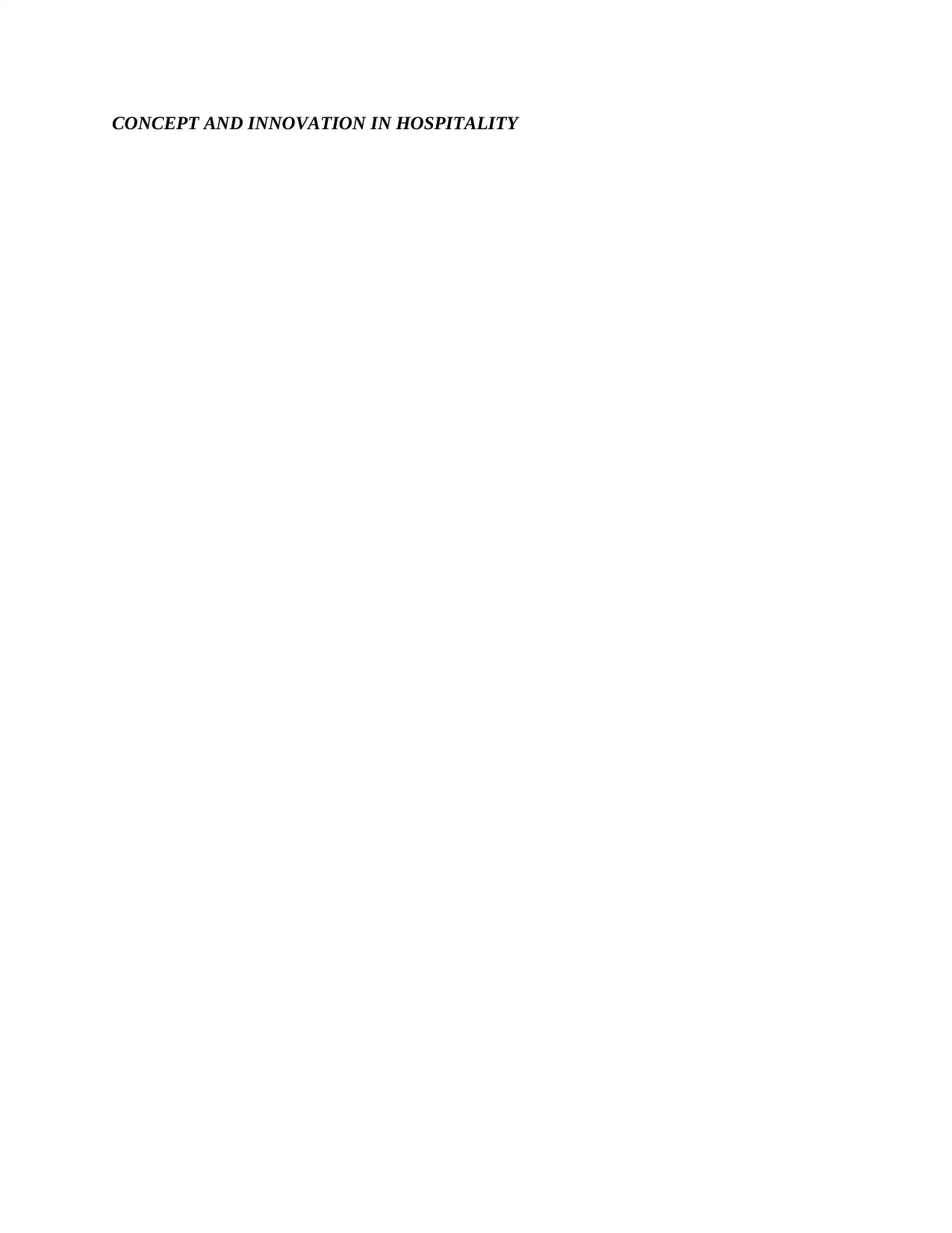
CONCEPT AND INNOVATION IN HOSPITALITY
Paraphrase This Document
Need a fresh take? Get an instant paraphrase of this document with our AI Paraphraser
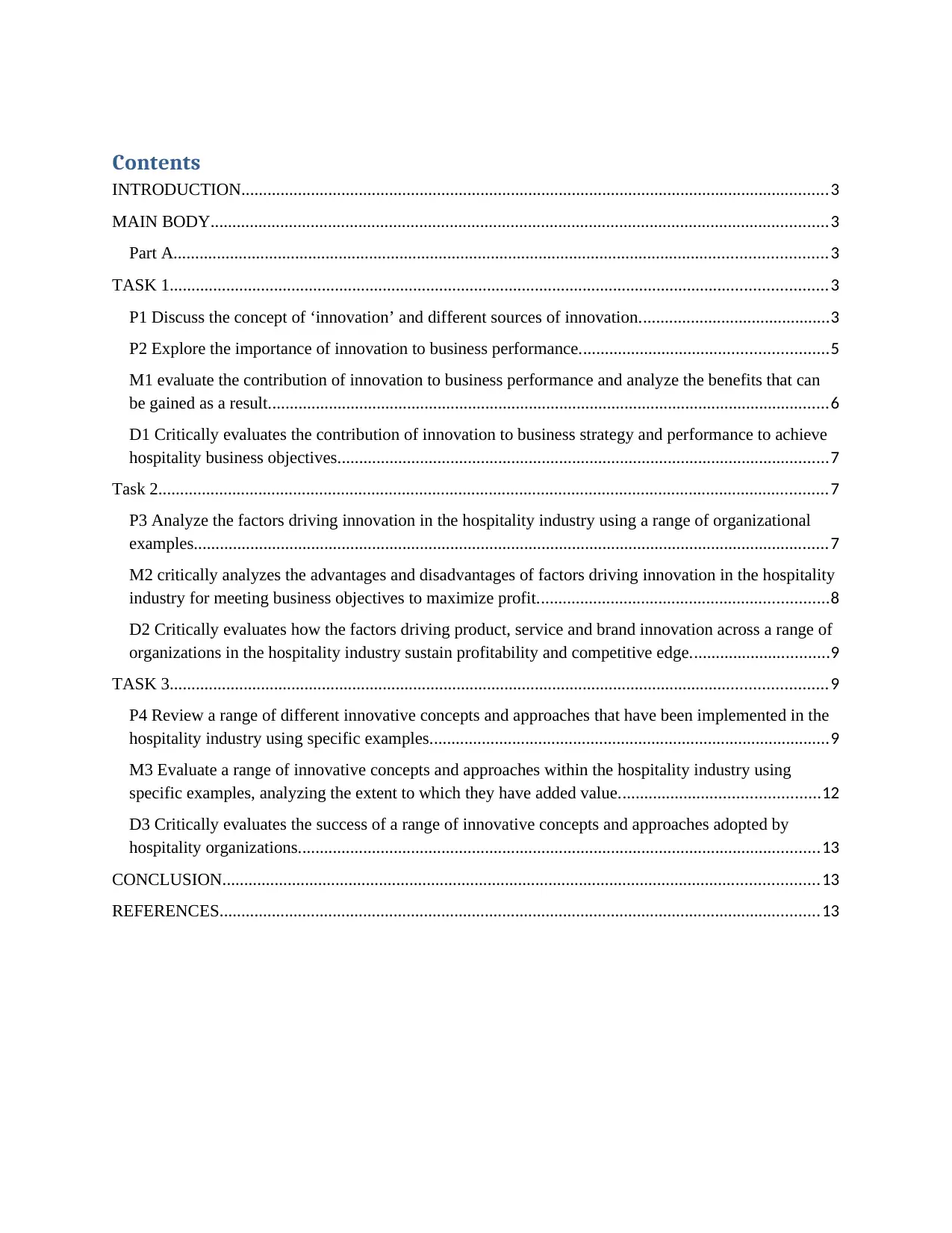
Contents
INTRODUCTION.......................................................................................................................................3
MAIN BODY..............................................................................................................................................3
Part A......................................................................................................................................................3
TASK 1.......................................................................................................................................................3
P1 Discuss the concept of ‘innovation’ and different sources of innovation............................................3
P2 Explore the importance of innovation to business performance.........................................................5
M1 evaluate the contribution of innovation to business performance and analyze the benefits that can
be gained as a result.................................................................................................................................6
D1 Critically evaluates the contribution of innovation to business strategy and performance to achieve
hospitality business objectives.................................................................................................................7
Task 2..........................................................................................................................................................7
P3 Analyze the factors driving innovation in the hospitality industry using a range of organizational
examples..................................................................................................................................................7
M2 critically analyzes the advantages and disadvantages of factors driving innovation in the hospitality
industry for meeting business objectives to maximize profit...................................................................8
D2 Critically evaluates how the factors driving product, service and brand innovation across a range of
organizations in the hospitality industry sustain profitability and competitive edge................................9
TASK 3.......................................................................................................................................................9
P4 Review a range of different innovative concepts and approaches that have been implemented in the
hospitality industry using specific examples............................................................................................9
M3 Evaluate a range of innovative concepts and approaches within the hospitality industry using
specific examples, analyzing the extent to which they have added value..............................................12
D3 Critically evaluates the success of a range of innovative concepts and approaches adopted by
hospitality organizations........................................................................................................................13
CONCLUSION.........................................................................................................................................13
REFERENCES..........................................................................................................................................13
INTRODUCTION.......................................................................................................................................3
MAIN BODY..............................................................................................................................................3
Part A......................................................................................................................................................3
TASK 1.......................................................................................................................................................3
P1 Discuss the concept of ‘innovation’ and different sources of innovation............................................3
P2 Explore the importance of innovation to business performance.........................................................5
M1 evaluate the contribution of innovation to business performance and analyze the benefits that can
be gained as a result.................................................................................................................................6
D1 Critically evaluates the contribution of innovation to business strategy and performance to achieve
hospitality business objectives.................................................................................................................7
Task 2..........................................................................................................................................................7
P3 Analyze the factors driving innovation in the hospitality industry using a range of organizational
examples..................................................................................................................................................7
M2 critically analyzes the advantages and disadvantages of factors driving innovation in the hospitality
industry for meeting business objectives to maximize profit...................................................................8
D2 Critically evaluates how the factors driving product, service and brand innovation across a range of
organizations in the hospitality industry sustain profitability and competitive edge................................9
TASK 3.......................................................................................................................................................9
P4 Review a range of different innovative concepts and approaches that have been implemented in the
hospitality industry using specific examples............................................................................................9
M3 Evaluate a range of innovative concepts and approaches within the hospitality industry using
specific examples, analyzing the extent to which they have added value..............................................12
D3 Critically evaluates the success of a range of innovative concepts and approaches adopted by
hospitality organizations........................................................................................................................13
CONCLUSION.........................................................................................................................................13
REFERENCES..........................................................................................................................................13
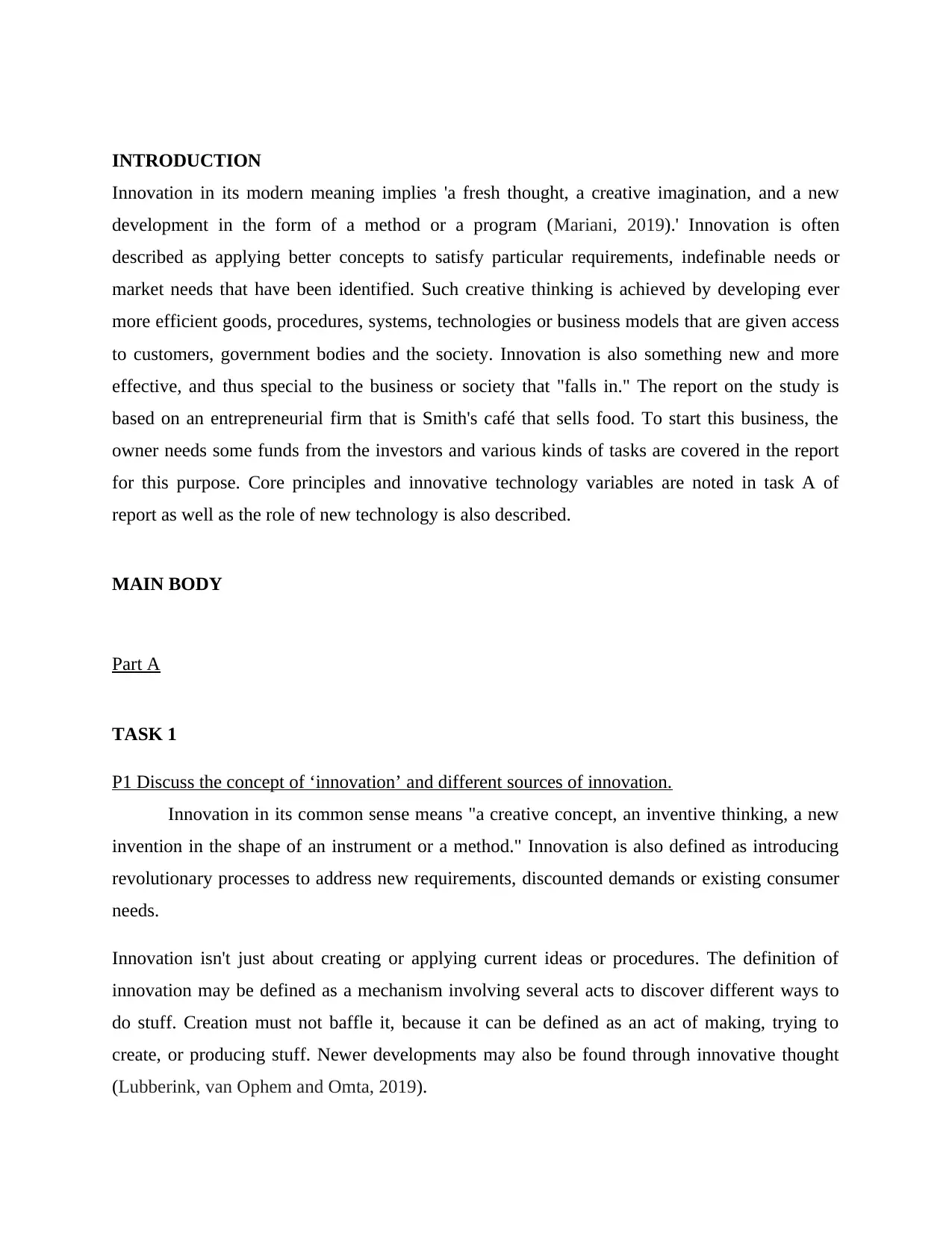
INTRODUCTION
Innovation in its modern meaning implies 'a fresh thought, a creative imagination, and a new
development in the form of a method or a program (Mariani, 2019).' Innovation is often
described as applying better concepts to satisfy particular requirements, indefinable needs or
market needs that have been identified. Such creative thinking is achieved by developing ever
more efficient goods, procedures, systems, technologies or business models that are given access
to customers, government bodies and the society. Innovation is also something new and more
effective, and thus special to the business or society that "falls in." The report on the study is
based on an entrepreneurial firm that is Smith's café that sells food. To start this business, the
owner needs some funds from the investors and various kinds of tasks are covered in the report
for this purpose. Core principles and innovative technology variables are noted in task A of
report as well as the role of new technology is also described.
MAIN BODY
Part A
TASK 1
P1 Discuss the concept of ‘innovation’ and different sources of innovation.
Innovation in its common sense means "a creative concept, an inventive thinking, a new
invention in the shape of an instrument or a method." Innovation is also defined as introducing
revolutionary processes to address new requirements, discounted demands or existing consumer
needs.
Innovation isn't just about creating or applying current ideas or procedures. The definition of
innovation may be defined as a mechanism involving several acts to discover different ways to
do stuff. Creation must not baffle it, because it can be defined as an act of making, trying to
create, or producing stuff. Newer developments may also be found through innovative thought
(Lubberink, van Ophem and Omta, 2019).
Innovation in its modern meaning implies 'a fresh thought, a creative imagination, and a new
development in the form of a method or a program (Mariani, 2019).' Innovation is often
described as applying better concepts to satisfy particular requirements, indefinable needs or
market needs that have been identified. Such creative thinking is achieved by developing ever
more efficient goods, procedures, systems, technologies or business models that are given access
to customers, government bodies and the society. Innovation is also something new and more
effective, and thus special to the business or society that "falls in." The report on the study is
based on an entrepreneurial firm that is Smith's café that sells food. To start this business, the
owner needs some funds from the investors and various kinds of tasks are covered in the report
for this purpose. Core principles and innovative technology variables are noted in task A of
report as well as the role of new technology is also described.
MAIN BODY
Part A
TASK 1
P1 Discuss the concept of ‘innovation’ and different sources of innovation.
Innovation in its common sense means "a creative concept, an inventive thinking, a new
invention in the shape of an instrument or a method." Innovation is also defined as introducing
revolutionary processes to address new requirements, discounted demands or existing consumer
needs.
Innovation isn't just about creating or applying current ideas or procedures. The definition of
innovation may be defined as a mechanism involving several acts to discover different ways to
do stuff. Creation must not baffle it, because it can be defined as an act of making, trying to
create, or producing stuff. Newer developments may also be found through innovative thought
(Lubberink, van Ophem and Omta, 2019).
⊘ This is a preview!⊘
Do you want full access?
Subscribe today to unlock all pages.

Trusted by 1+ million students worldwide
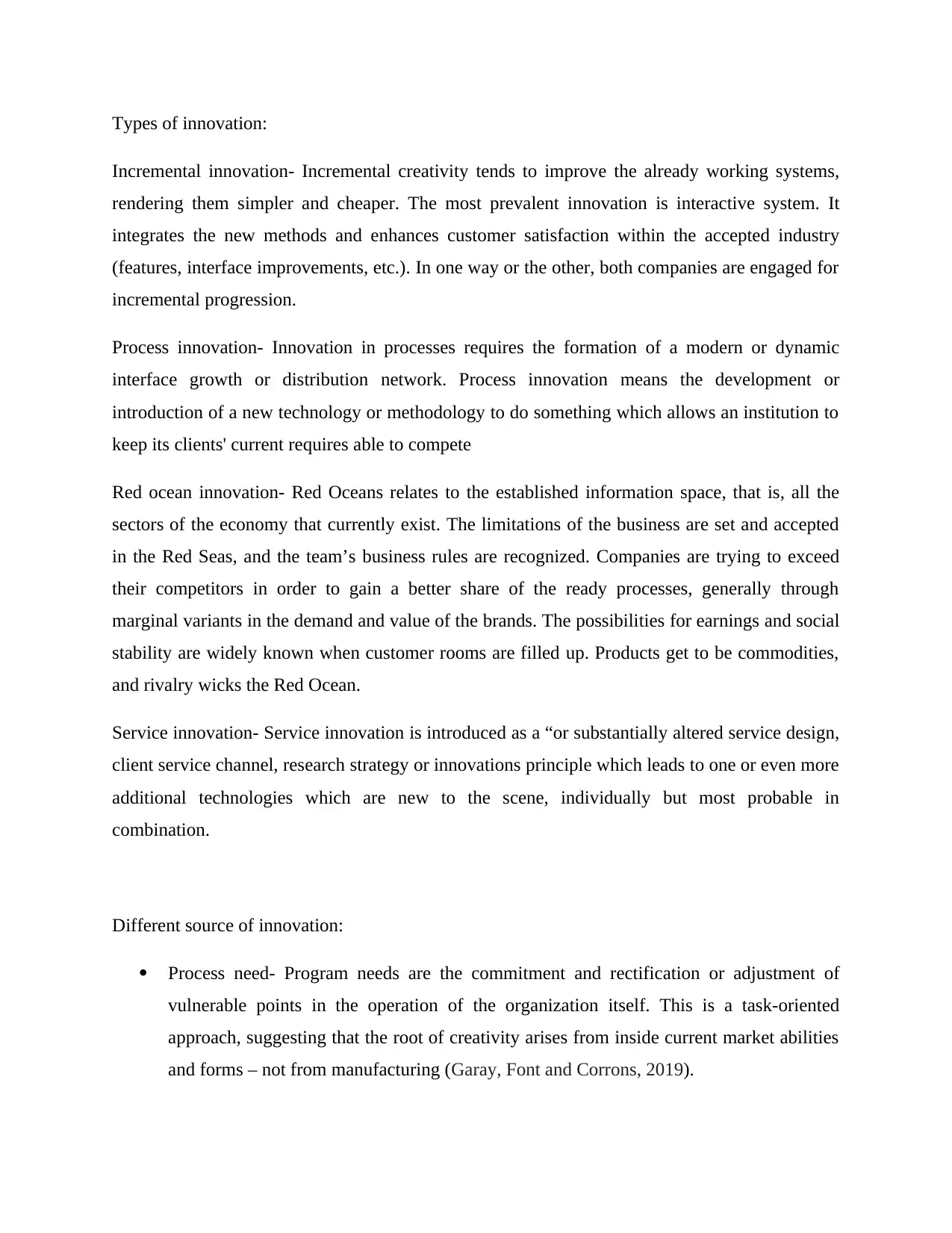
Types of innovation:
Incremental innovation- Incremental creativity tends to improve the already working systems,
rendering them simpler and cheaper. The most prevalent innovation is interactive system. It
integrates the new methods and enhances customer satisfaction within the accepted industry
(features, interface improvements, etc.). In one way or the other, both companies are engaged for
incremental progression.
Process innovation- Innovation in processes requires the formation of a modern or dynamic
interface growth or distribution network. Process innovation means the development or
introduction of a new technology or methodology to do something which allows an institution to
keep its clients' current requires able to compete
Red ocean innovation- Red Oceans relates to the established information space, that is, all the
sectors of the economy that currently exist. The limitations of the business are set and accepted
in the Red Seas, and the team’s business rules are recognized. Companies are trying to exceed
their competitors in order to gain a better share of the ready processes, generally through
marginal variants in the demand and value of the brands. The possibilities for earnings and social
stability are widely known when customer rooms are filled up. Products get to be commodities,
and rivalry wicks the Red Ocean.
Service innovation- Service innovation is introduced as a “or substantially altered service design,
client service channel, research strategy or innovations principle which leads to one or even more
additional technologies which are new to the scene, individually but most probable in
combination.
Different source of innovation:
Process need- Program needs are the commitment and rectification or adjustment of
vulnerable points in the operation of the organization itself. This is a task-oriented
approach, suggesting that the root of creativity arises from inside current market abilities
and forms – not from manufacturing (Garay, Font and Corrons, 2019).
Incremental innovation- Incremental creativity tends to improve the already working systems,
rendering them simpler and cheaper. The most prevalent innovation is interactive system. It
integrates the new methods and enhances customer satisfaction within the accepted industry
(features, interface improvements, etc.). In one way or the other, both companies are engaged for
incremental progression.
Process innovation- Innovation in processes requires the formation of a modern or dynamic
interface growth or distribution network. Process innovation means the development or
introduction of a new technology or methodology to do something which allows an institution to
keep its clients' current requires able to compete
Red ocean innovation- Red Oceans relates to the established information space, that is, all the
sectors of the economy that currently exist. The limitations of the business are set and accepted
in the Red Seas, and the team’s business rules are recognized. Companies are trying to exceed
their competitors in order to gain a better share of the ready processes, generally through
marginal variants in the demand and value of the brands. The possibilities for earnings and social
stability are widely known when customer rooms are filled up. Products get to be commodities,
and rivalry wicks the Red Ocean.
Service innovation- Service innovation is introduced as a “or substantially altered service design,
client service channel, research strategy or innovations principle which leads to one or even more
additional technologies which are new to the scene, individually but most probable in
combination.
Different source of innovation:
Process need- Program needs are the commitment and rectification or adjustment of
vulnerable points in the operation of the organization itself. This is a task-oriented
approach, suggesting that the root of creativity arises from inside current market abilities
and forms – not from manufacturing (Garay, Font and Corrons, 2019).
Paraphrase This Document
Need a fresh take? Get an instant paraphrase of this document with our AI Paraphraser
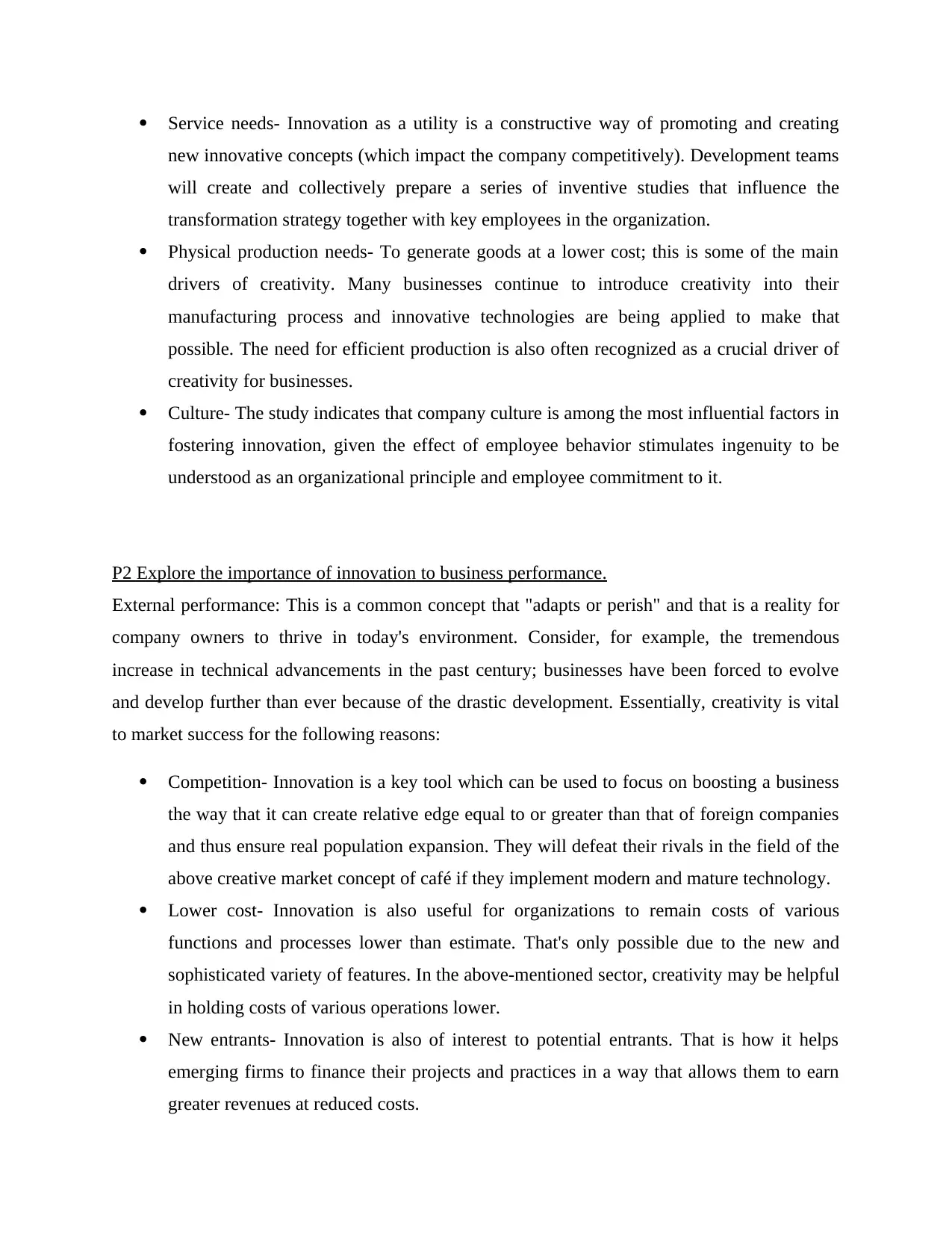
Service needs- Innovation as a utility is a constructive way of promoting and creating
new innovative concepts (which impact the company competitively). Development teams
will create and collectively prepare a series of inventive studies that influence the
transformation strategy together with key employees in the organization.
Physical production needs- To generate goods at a lower cost; this is some of the main
drivers of creativity. Many businesses continue to introduce creativity into their
manufacturing process and innovative technologies are being applied to make that
possible. The need for efficient production is also often recognized as a crucial driver of
creativity for businesses.
Culture- The study indicates that company culture is among the most influential factors in
fostering innovation, given the effect of employee behavior stimulates ingenuity to be
understood as an organizational principle and employee commitment to it.
P2 Explore the importance of innovation to business performance.
External performance: This is a common concept that "adapts or perish" and that is a reality for
company owners to thrive in today's environment. Consider, for example, the tremendous
increase in technical advancements in the past century; businesses have been forced to evolve
and develop further than ever because of the drastic development. Essentially, creativity is vital
to market success for the following reasons:
Competition- Innovation is a key tool which can be used to focus on boosting a business
the way that it can create relative edge equal to or greater than that of foreign companies
and thus ensure real population expansion. They will defeat their rivals in the field of the
above creative market concept of café if they implement modern and mature technology.
Lower cost- Innovation is also useful for organizations to remain costs of various
functions and processes lower than estimate. That's only possible due to the new and
sophisticated variety of features. In the above-mentioned sector, creativity may be helpful
in holding costs of various operations lower.
New entrants- Innovation is also of interest to potential entrants. That is how it helps
emerging firms to finance their projects and practices in a way that allows them to earn
greater revenues at reduced costs.
new innovative concepts (which impact the company competitively). Development teams
will create and collectively prepare a series of inventive studies that influence the
transformation strategy together with key employees in the organization.
Physical production needs- To generate goods at a lower cost; this is some of the main
drivers of creativity. Many businesses continue to introduce creativity into their
manufacturing process and innovative technologies are being applied to make that
possible. The need for efficient production is also often recognized as a crucial driver of
creativity for businesses.
Culture- The study indicates that company culture is among the most influential factors in
fostering innovation, given the effect of employee behavior stimulates ingenuity to be
understood as an organizational principle and employee commitment to it.
P2 Explore the importance of innovation to business performance.
External performance: This is a common concept that "adapts or perish" and that is a reality for
company owners to thrive in today's environment. Consider, for example, the tremendous
increase in technical advancements in the past century; businesses have been forced to evolve
and develop further than ever because of the drastic development. Essentially, creativity is vital
to market success for the following reasons:
Competition- Innovation is a key tool which can be used to focus on boosting a business
the way that it can create relative edge equal to or greater than that of foreign companies
and thus ensure real population expansion. They will defeat their rivals in the field of the
above creative market concept of café if they implement modern and mature technology.
Lower cost- Innovation is also useful for organizations to remain costs of various
functions and processes lower than estimate. That's only possible due to the new and
sophisticated variety of features. In the above-mentioned sector, creativity may be helpful
in holding costs of various operations lower.
New entrants- Innovation is also of interest to potential entrants. That is how it helps
emerging firms to finance their projects and practices in a way that allows them to earn
greater revenues at reduced costs.
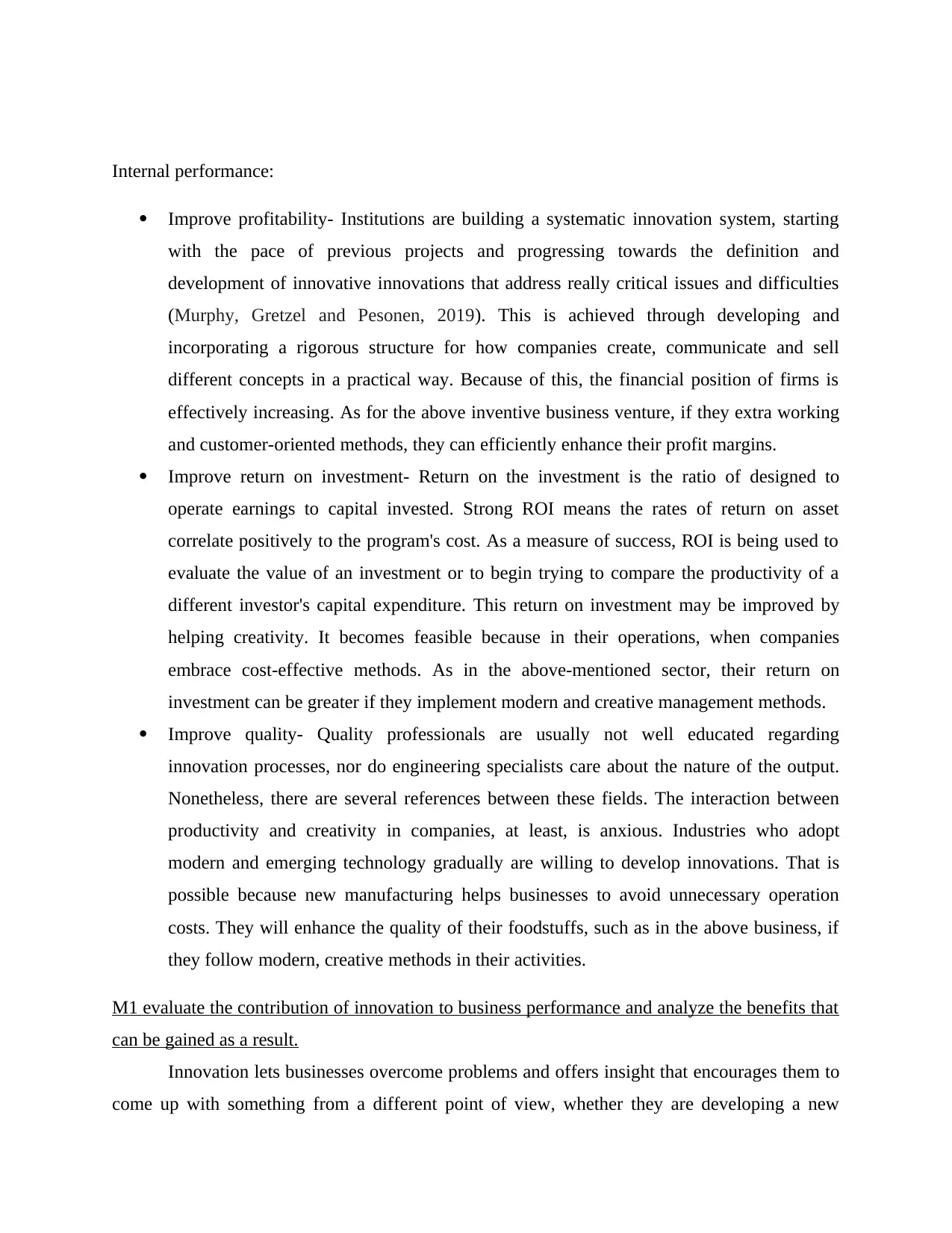
Internal performance:
Improve profitability- Institutions are building a systematic innovation system, starting
with the pace of previous projects and progressing towards the definition and
development of innovative innovations that address really critical issues and difficulties
(Murphy, Gretzel and Pesonen, 2019). This is achieved through developing and
incorporating a rigorous structure for how companies create, communicate and sell
different concepts in a practical way. Because of this, the financial position of firms is
effectively increasing. As for the above inventive business venture, if they extra working
and customer-oriented methods, they can efficiently enhance their profit margins.
Improve return on investment- Return on the investment is the ratio of designed to
operate earnings to capital invested. Strong ROI means the rates of return on asset
correlate positively to the program's cost. As a measure of success, ROI is being used to
evaluate the value of an investment or to begin trying to compare the productivity of a
different investor's capital expenditure. This return on investment may be improved by
helping creativity. It becomes feasible because in their operations, when companies
embrace cost-effective methods. As in the above-mentioned sector, their return on
investment can be greater if they implement modern and creative management methods.
Improve quality- Quality professionals are usually not well educated regarding
innovation processes, nor do engineering specialists care about the nature of the output.
Nonetheless, there are several references between these fields. The interaction between
productivity and creativity in companies, at least, is anxious. Industries who adopt
modern and emerging technology gradually are willing to develop innovations. That is
possible because new manufacturing helps businesses to avoid unnecessary operation
costs. They will enhance the quality of their foodstuffs, such as in the above business, if
they follow modern, creative methods in their activities.
M1 evaluate the contribution of innovation to business performance and analyze the benefits that
can be gained as a result.
Innovation lets businesses overcome problems and offers insight that encourages them to
come up with something from a different point of view, whether they are developing a new
Improve profitability- Institutions are building a systematic innovation system, starting
with the pace of previous projects and progressing towards the definition and
development of innovative innovations that address really critical issues and difficulties
(Murphy, Gretzel and Pesonen, 2019). This is achieved through developing and
incorporating a rigorous structure for how companies create, communicate and sell
different concepts in a practical way. Because of this, the financial position of firms is
effectively increasing. As for the above inventive business venture, if they extra working
and customer-oriented methods, they can efficiently enhance their profit margins.
Improve return on investment- Return on the investment is the ratio of designed to
operate earnings to capital invested. Strong ROI means the rates of return on asset
correlate positively to the program's cost. As a measure of success, ROI is being used to
evaluate the value of an investment or to begin trying to compare the productivity of a
different investor's capital expenditure. This return on investment may be improved by
helping creativity. It becomes feasible because in their operations, when companies
embrace cost-effective methods. As in the above-mentioned sector, their return on
investment can be greater if they implement modern and creative management methods.
Improve quality- Quality professionals are usually not well educated regarding
innovation processes, nor do engineering specialists care about the nature of the output.
Nonetheless, there are several references between these fields. The interaction between
productivity and creativity in companies, at least, is anxious. Industries who adopt
modern and emerging technology gradually are willing to develop innovations. That is
possible because new manufacturing helps businesses to avoid unnecessary operation
costs. They will enhance the quality of their foodstuffs, such as in the above business, if
they follow modern, creative methods in their activities.
M1 evaluate the contribution of innovation to business performance and analyze the benefits that
can be gained as a result.
Innovation lets businesses overcome problems and offers insight that encourages them to
come up with something from a different point of view, whether they are developing a new
⊘ This is a preview!⊘
Do you want full access?
Subscribe today to unlock all pages.

Trusted by 1+ million students worldwide
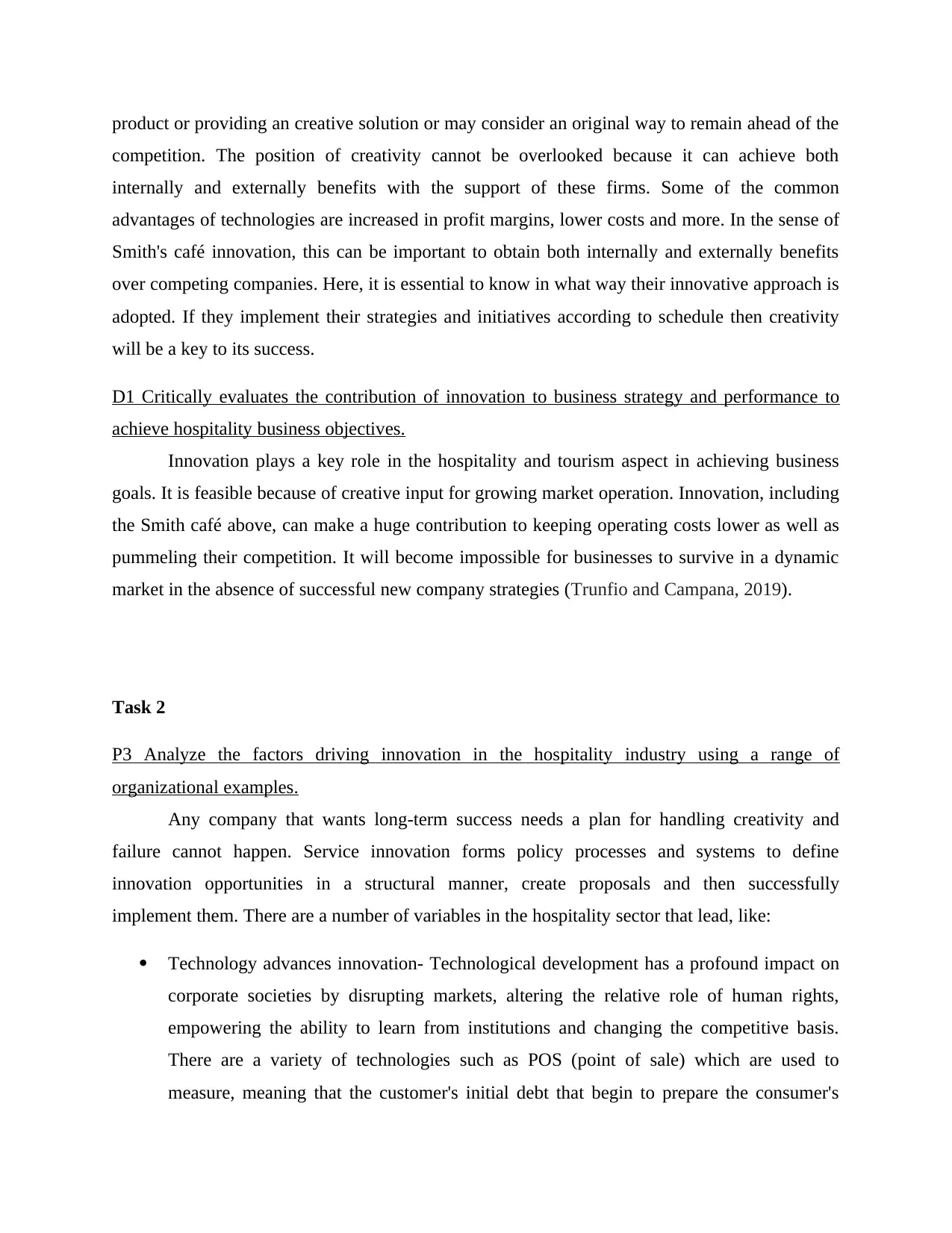
product or providing an creative solution or may consider an original way to remain ahead of the
competition. The position of creativity cannot be overlooked because it can achieve both
internally and externally benefits with the support of these firms. Some of the common
advantages of technologies are increased in profit margins, lower costs and more. In the sense of
Smith's café innovation, this can be important to obtain both internally and externally benefits
over competing companies. Here, it is essential to know in what way their innovative approach is
adopted. If they implement their strategies and initiatives according to schedule then creativity
will be a key to its success.
D1 Critically evaluates the contribution of innovation to business strategy and performance to
achieve hospitality business objectives.
Innovation plays a key role in the hospitality and tourism aspect in achieving business
goals. It is feasible because of creative input for growing market operation. Innovation, including
the Smith café above, can make a huge contribution to keeping operating costs lower as well as
pummeling their competition. It will become impossible for businesses to survive in a dynamic
market in the absence of successful new company strategies (Trunfio and Campana, 2019).
Task 2
P3 Analyze the factors driving innovation in the hospitality industry using a range of
organizational examples.
Any company that wants long-term success needs a plan for handling creativity and
failure cannot happen. Service innovation forms policy processes and systems to define
innovation opportunities in a structural manner, create proposals and then successfully
implement them. There are a number of variables in the hospitality sector that lead, like:
Technology advances innovation- Technological development has a profound impact on
corporate societies by disrupting markets, altering the relative role of human rights,
empowering the ability to learn from institutions and changing the competitive basis.
There are a variety of technologies such as POS (point of sale) which are used to
measure, meaning that the customer's initial debt that begin to prepare the consumer's
competition. The position of creativity cannot be overlooked because it can achieve both
internally and externally benefits with the support of these firms. Some of the common
advantages of technologies are increased in profit margins, lower costs and more. In the sense of
Smith's café innovation, this can be important to obtain both internally and externally benefits
over competing companies. Here, it is essential to know in what way their innovative approach is
adopted. If they implement their strategies and initiatives according to schedule then creativity
will be a key to its success.
D1 Critically evaluates the contribution of innovation to business strategy and performance to
achieve hospitality business objectives.
Innovation plays a key role in the hospitality and tourism aspect in achieving business
goals. It is feasible because of creative input for growing market operation. Innovation, including
the Smith café above, can make a huge contribution to keeping operating costs lower as well as
pummeling their competition. It will become impossible for businesses to survive in a dynamic
market in the absence of successful new company strategies (Trunfio and Campana, 2019).
Task 2
P3 Analyze the factors driving innovation in the hospitality industry using a range of
organizational examples.
Any company that wants long-term success needs a plan for handling creativity and
failure cannot happen. Service innovation forms policy processes and systems to define
innovation opportunities in a structural manner, create proposals and then successfully
implement them. There are a number of variables in the hospitality sector that lead, like:
Technology advances innovation- Technological development has a profound impact on
corporate societies by disrupting markets, altering the relative role of human rights,
empowering the ability to learn from institutions and changing the competitive basis.
There are a variety of technologies such as POS (point of sale) which are used to
measure, meaning that the customer's initial debt that begin to prepare the consumer's
Paraphrase This Document
Need a fresh take? Get an instant paraphrase of this document with our AI Paraphraser
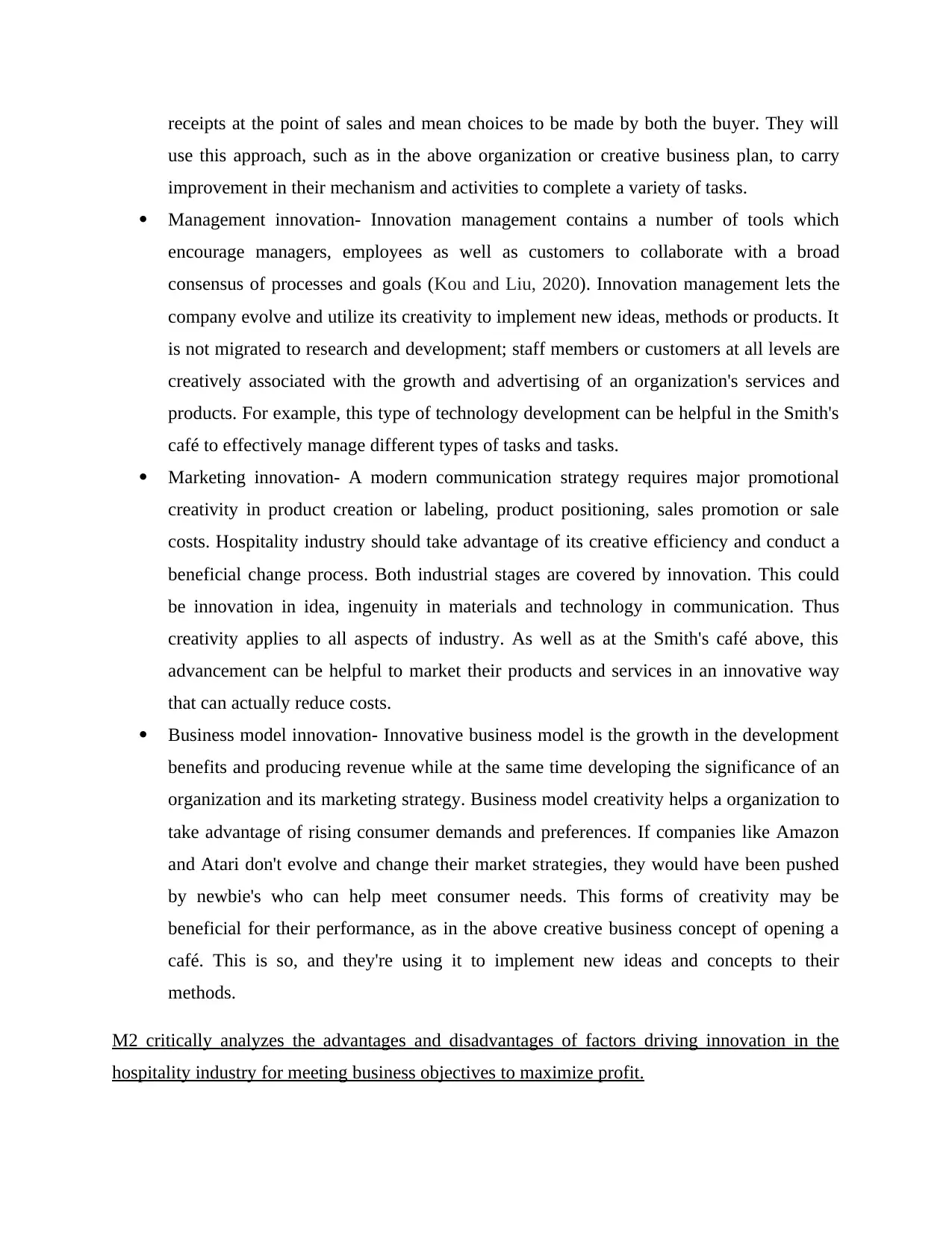
receipts at the point of sales and mean choices to be made by both the buyer. They will
use this approach, such as in the above organization or creative business plan, to carry
improvement in their mechanism and activities to complete a variety of tasks.
Management innovation- Innovation management contains a number of tools which
encourage managers, employees as well as customers to collaborate with a broad
consensus of processes and goals (Kou and Liu, 2020). Innovation management lets the
company evolve and utilize its creativity to implement new ideas, methods or products. It
is not migrated to research and development; staff members or customers at all levels are
creatively associated with the growth and advertising of an organization's services and
products. For example, this type of technology development can be helpful in the Smith's
café to effectively manage different types of tasks and tasks.
Marketing innovation- A modern communication strategy requires major promotional
creativity in product creation or labeling, product positioning, sales promotion or sale
costs. Hospitality industry should take advantage of its creative efficiency and conduct a
beneficial change process. Both industrial stages are covered by innovation. This could
be innovation in idea, ingenuity in materials and technology in communication. Thus
creativity applies to all aspects of industry. As well as at the Smith's café above, this
advancement can be helpful to market their products and services in an innovative way
that can actually reduce costs.
Business model innovation- Innovative business model is the growth in the development
benefits and producing revenue while at the same time developing the significance of an
organization and its marketing strategy. Business model creativity helps a organization to
take advantage of rising consumer demands and preferences. If companies like Amazon
and Atari don't evolve and change their market strategies, they would have been pushed
by newbie's who can help meet consumer needs. This forms of creativity may be
beneficial for their performance, as in the above creative business concept of opening a
café. This is so, and they're using it to implement new ideas and concepts to their
methods.
M2 critically analyzes the advantages and disadvantages of factors driving innovation in the
hospitality industry for meeting business objectives to maximize profit.
use this approach, such as in the above organization or creative business plan, to carry
improvement in their mechanism and activities to complete a variety of tasks.
Management innovation- Innovation management contains a number of tools which
encourage managers, employees as well as customers to collaborate with a broad
consensus of processes and goals (Kou and Liu, 2020). Innovation management lets the
company evolve and utilize its creativity to implement new ideas, methods or products. It
is not migrated to research and development; staff members or customers at all levels are
creatively associated with the growth and advertising of an organization's services and
products. For example, this type of technology development can be helpful in the Smith's
café to effectively manage different types of tasks and tasks.
Marketing innovation- A modern communication strategy requires major promotional
creativity in product creation or labeling, product positioning, sales promotion or sale
costs. Hospitality industry should take advantage of its creative efficiency and conduct a
beneficial change process. Both industrial stages are covered by innovation. This could
be innovation in idea, ingenuity in materials and technology in communication. Thus
creativity applies to all aspects of industry. As well as at the Smith's café above, this
advancement can be helpful to market their products and services in an innovative way
that can actually reduce costs.
Business model innovation- Innovative business model is the growth in the development
benefits and producing revenue while at the same time developing the significance of an
organization and its marketing strategy. Business model creativity helps a organization to
take advantage of rising consumer demands and preferences. If companies like Amazon
and Atari don't evolve and change their market strategies, they would have been pushed
by newbie's who can help meet consumer needs. This forms of creativity may be
beneficial for their performance, as in the above creative business concept of opening a
café. This is so, and they're using it to implement new ideas and concepts to their
methods.
M2 critically analyzes the advantages and disadvantages of factors driving innovation in the
hospitality industry for meeting business objectives to maximize profit.
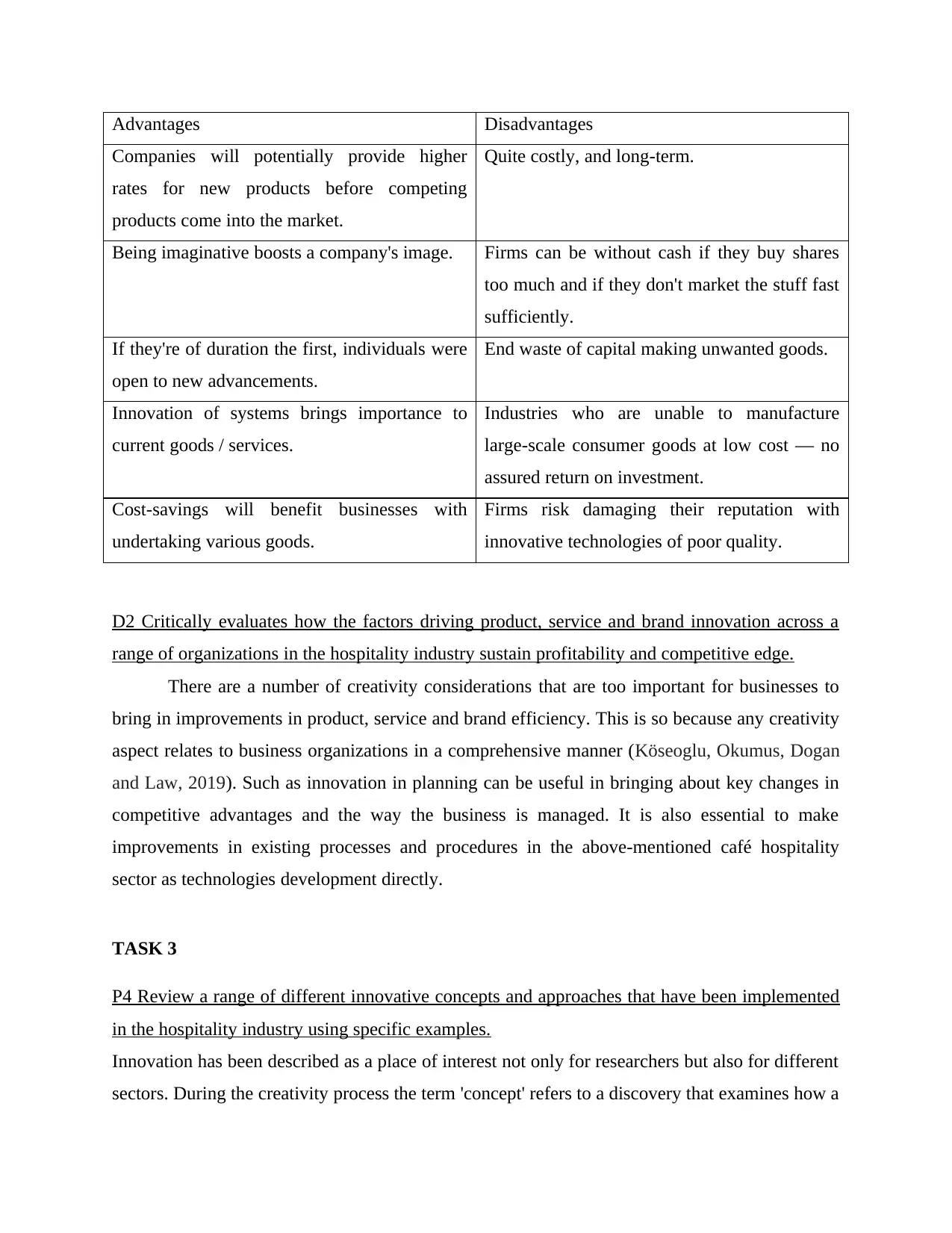
Advantages Disadvantages
Companies will potentially provide higher
rates for new products before competing
products come into the market.
Quite costly, and long-term.
Being imaginative boosts a company's image. Firms can be without cash if they buy shares
too much and if they don't market the stuff fast
sufficiently.
If they're of duration the first, individuals were
open to new advancements.
End waste of capital making unwanted goods.
Innovation of systems brings importance to
current goods / services.
Industries who are unable to manufacture
large-scale consumer goods at low cost — no
assured return on investment.
Cost-savings will benefit businesses with
undertaking various goods.
Firms risk damaging their reputation with
innovative technologies of poor quality.
D2 Critically evaluates how the factors driving product, service and brand innovation across a
range of organizations in the hospitality industry sustain profitability and competitive edge.
There are a number of creativity considerations that are too important for businesses to
bring in improvements in product, service and brand efficiency. This is so because any creativity
aspect relates to business organizations in a comprehensive manner (Köseoglu, Okumus, Dogan
and Law, 2019). Such as innovation in planning can be useful in bringing about key changes in
competitive advantages and the way the business is managed. It is also essential to make
improvements in existing processes and procedures in the above-mentioned café hospitality
sector as technologies development directly.
TASK 3
P4 Review a range of different innovative concepts and approaches that have been implemented
in the hospitality industry using specific examples.
Innovation has been described as a place of interest not only for researchers but also for different
sectors. During the creativity process the term 'concept' refers to a discovery that examines how a
Companies will potentially provide higher
rates for new products before competing
products come into the market.
Quite costly, and long-term.
Being imaginative boosts a company's image. Firms can be without cash if they buy shares
too much and if they don't market the stuff fast
sufficiently.
If they're of duration the first, individuals were
open to new advancements.
End waste of capital making unwanted goods.
Innovation of systems brings importance to
current goods / services.
Industries who are unable to manufacture
large-scale consumer goods at low cost — no
assured return on investment.
Cost-savings will benefit businesses with
undertaking various goods.
Firms risk damaging their reputation with
innovative technologies of poor quality.
D2 Critically evaluates how the factors driving product, service and brand innovation across a
range of organizations in the hospitality industry sustain profitability and competitive edge.
There are a number of creativity considerations that are too important for businesses to
bring in improvements in product, service and brand efficiency. This is so because any creativity
aspect relates to business organizations in a comprehensive manner (Köseoglu, Okumus, Dogan
and Law, 2019). Such as innovation in planning can be useful in bringing about key changes in
competitive advantages and the way the business is managed. It is also essential to make
improvements in existing processes and procedures in the above-mentioned café hospitality
sector as technologies development directly.
TASK 3
P4 Review a range of different innovative concepts and approaches that have been implemented
in the hospitality industry using specific examples.
Innovation has been described as a place of interest not only for researchers but also for different
sectors. During the creativity process the term 'concept' refers to a discovery that examines how a
⊘ This is a preview!⊘
Do you want full access?
Subscribe today to unlock all pages.

Trusted by 1+ million students worldwide
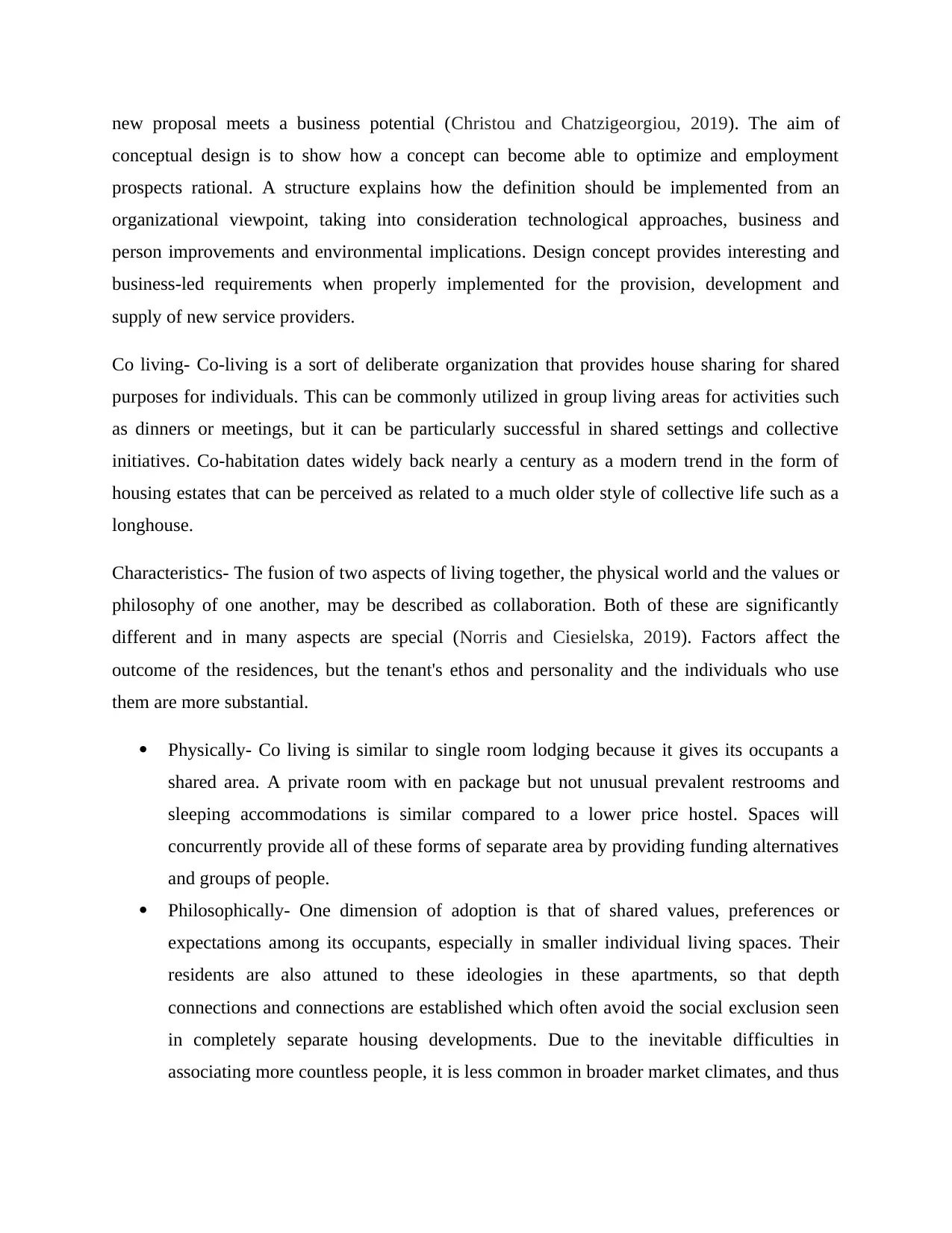
new proposal meets a business potential (Christou and Chatzigeorgiou, 2019). The aim of
conceptual design is to show how a concept can become able to optimize and employment
prospects rational. A structure explains how the definition should be implemented from an
organizational viewpoint, taking into consideration technological approaches, business and
person improvements and environmental implications. Design concept provides interesting and
business-led requirements when properly implemented for the provision, development and
supply of new service providers.
Co living- Co-living is a sort of deliberate organization that provides house sharing for shared
purposes for individuals. This can be commonly utilized in group living areas for activities such
as dinners or meetings, but it can be particularly successful in shared settings and collective
initiatives. Co-habitation dates widely back nearly a century as a modern trend in the form of
housing estates that can be perceived as related to a much older style of collective life such as a
longhouse.
Characteristics- The fusion of two aspects of living together, the physical world and the values or
philosophy of one another, may be described as collaboration. Both of these are significantly
different and in many aspects are special (Norris and Ciesielska, 2019). Factors affect the
outcome of the residences, but the tenant's ethos and personality and the individuals who use
them are more substantial.
Physically- Co living is similar to single room lodging because it gives its occupants a
shared area. A private room with en package but not unusual prevalent restrooms and
sleeping accommodations is similar compared to a lower price hostel. Spaces will
concurrently provide all of these forms of separate area by providing funding alternatives
and groups of people.
Philosophically- One dimension of adoption is that of shared values, preferences or
expectations among its occupants, especially in smaller individual living spaces. Their
residents are also attuned to these ideologies in these apartments, so that depth
connections and connections are established which often avoid the social exclusion seen
in completely separate housing developments. Due to the inevitable difficulties in
associating more countless people, it is less common in broader market climates, and thus
conceptual design is to show how a concept can become able to optimize and employment
prospects rational. A structure explains how the definition should be implemented from an
organizational viewpoint, taking into consideration technological approaches, business and
person improvements and environmental implications. Design concept provides interesting and
business-led requirements when properly implemented for the provision, development and
supply of new service providers.
Co living- Co-living is a sort of deliberate organization that provides house sharing for shared
purposes for individuals. This can be commonly utilized in group living areas for activities such
as dinners or meetings, but it can be particularly successful in shared settings and collective
initiatives. Co-habitation dates widely back nearly a century as a modern trend in the form of
housing estates that can be perceived as related to a much older style of collective life such as a
longhouse.
Characteristics- The fusion of two aspects of living together, the physical world and the values or
philosophy of one another, may be described as collaboration. Both of these are significantly
different and in many aspects are special (Norris and Ciesielska, 2019). Factors affect the
outcome of the residences, but the tenant's ethos and personality and the individuals who use
them are more substantial.
Physically- Co living is similar to single room lodging because it gives its occupants a
shared area. A private room with en package but not unusual prevalent restrooms and
sleeping accommodations is similar compared to a lower price hostel. Spaces will
concurrently provide all of these forms of separate area by providing funding alternatives
and groups of people.
Philosophically- One dimension of adoption is that of shared values, preferences or
expectations among its occupants, especially in smaller individual living spaces. Their
residents are also attuned to these ideologies in these apartments, so that depth
connections and connections are established which often avoid the social exclusion seen
in completely separate housing developments. Due to the inevitable difficulties in
associating more countless people, it is less common in broader market climates, and thus
Paraphrase This Document
Need a fresh take? Get an instant paraphrase of this document with our AI Paraphraser
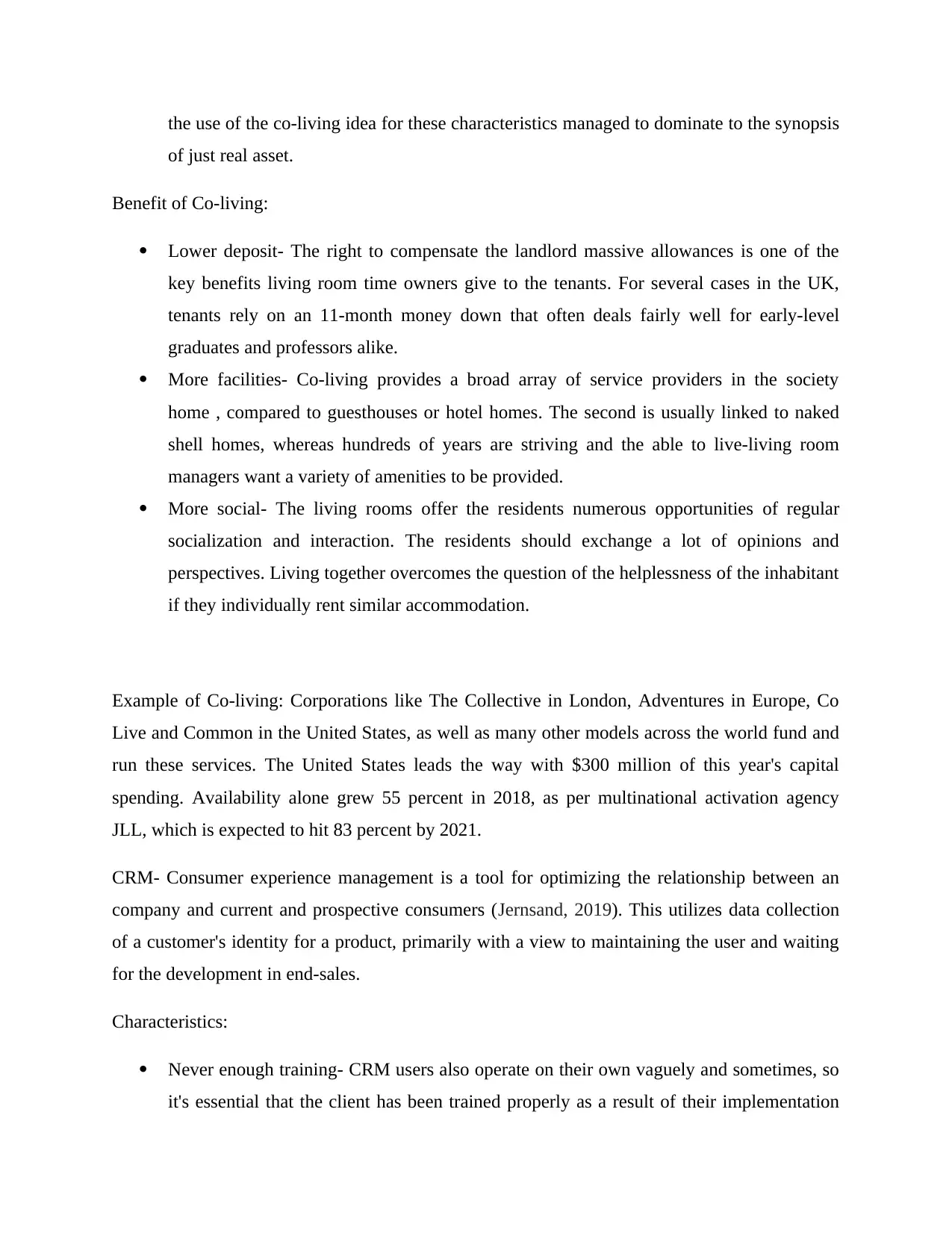
the use of the co-living idea for these characteristics managed to dominate to the synopsis
of just real asset.
Benefit of Co-living:
Lower deposit- The right to compensate the landlord massive allowances is one of the
key benefits living room time owners give to the tenants. For several cases in the UK,
tenants rely on an 11-month money down that often deals fairly well for early-level
graduates and professors alike.
More facilities- Co-living provides a broad array of service providers in the society
home , compared to guesthouses or hotel homes. The second is usually linked to naked
shell homes, whereas hundreds of years are striving and the able to live-living room
managers want a variety of amenities to be provided.
More social- The living rooms offer the residents numerous opportunities of regular
socialization and interaction. The residents should exchange a lot of opinions and
perspectives. Living together overcomes the question of the helplessness of the inhabitant
if they individually rent similar accommodation.
Example of Co-living: Corporations like The Collective in London, Adventures in Europe, Co
Live and Common in the United States, as well as many other models across the world fund and
run these services. The United States leads the way with $300 million of this year's capital
spending. Availability alone grew 55 percent in 2018, as per multinational activation agency
JLL, which is expected to hit 83 percent by 2021.
CRM- Consumer experience management is a tool for optimizing the relationship between an
company and current and prospective consumers (Jernsand, 2019). This utilizes data collection
of a customer's identity for a product, primarily with a view to maintaining the user and waiting
for the development in end-sales.
Characteristics:
Never enough training- CRM users also operate on their own vaguely and sometimes, so
it's essential that the client has been trained properly as a result of their implementation
of just real asset.
Benefit of Co-living:
Lower deposit- The right to compensate the landlord massive allowances is one of the
key benefits living room time owners give to the tenants. For several cases in the UK,
tenants rely on an 11-month money down that often deals fairly well for early-level
graduates and professors alike.
More facilities- Co-living provides a broad array of service providers in the society
home , compared to guesthouses or hotel homes. The second is usually linked to naked
shell homes, whereas hundreds of years are striving and the able to live-living room
managers want a variety of amenities to be provided.
More social- The living rooms offer the residents numerous opportunities of regular
socialization and interaction. The residents should exchange a lot of opinions and
perspectives. Living together overcomes the question of the helplessness of the inhabitant
if they individually rent similar accommodation.
Example of Co-living: Corporations like The Collective in London, Adventures in Europe, Co
Live and Common in the United States, as well as many other models across the world fund and
run these services. The United States leads the way with $300 million of this year's capital
spending. Availability alone grew 55 percent in 2018, as per multinational activation agency
JLL, which is expected to hit 83 percent by 2021.
CRM- Consumer experience management is a tool for optimizing the relationship between an
company and current and prospective consumers (Jernsand, 2019). This utilizes data collection
of a customer's identity for a product, primarily with a view to maintaining the user and waiting
for the development in end-sales.
Characteristics:
Never enough training- CRM users also operate on their own vaguely and sometimes, so
it's essential that the client has been trained properly as a result of their implementation
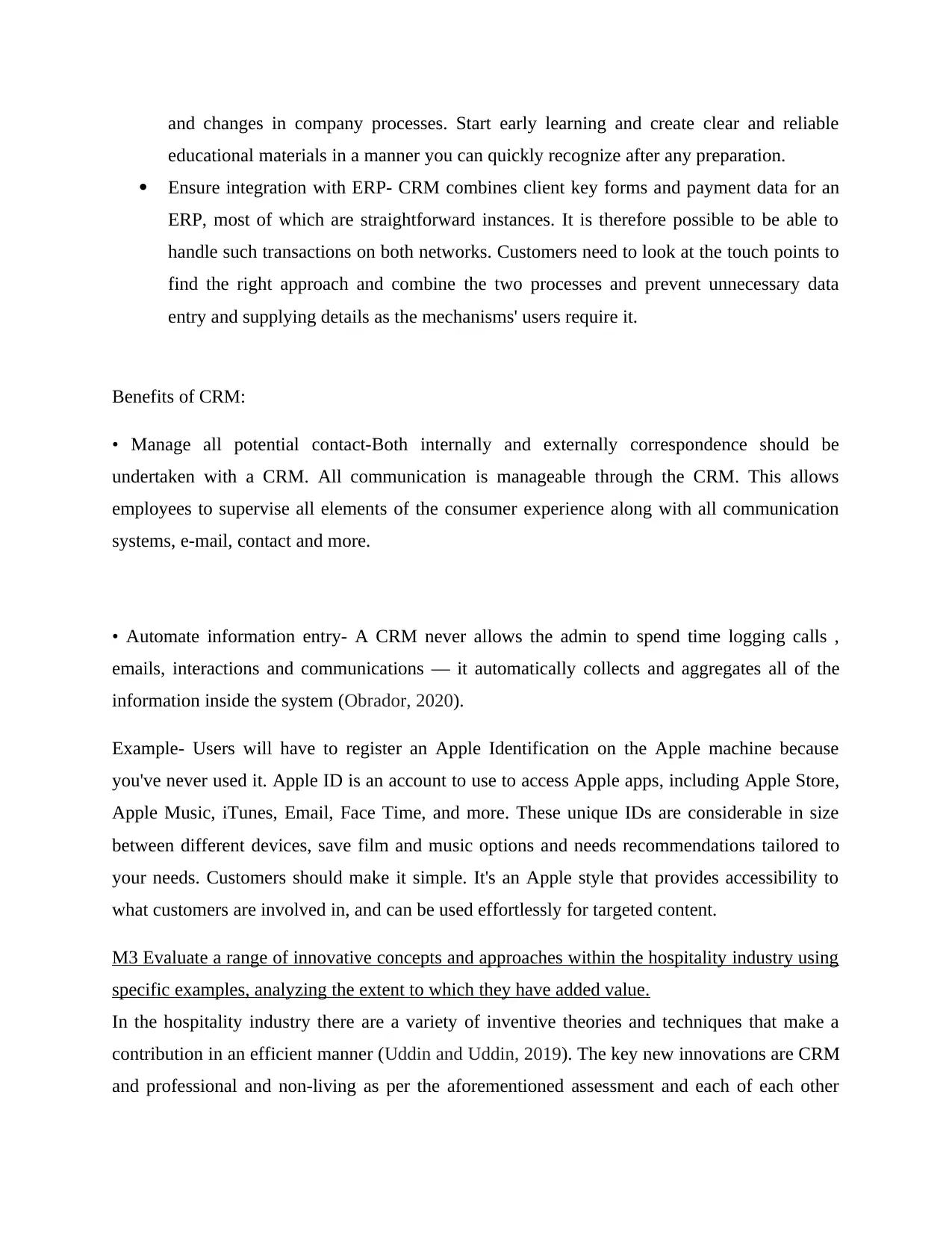
and changes in company processes. Start early learning and create clear and reliable
educational materials in a manner you can quickly recognize after any preparation.
Ensure integration with ERP- CRM combines client key forms and payment data for an
ERP, most of which are straightforward instances. It is therefore possible to be able to
handle such transactions on both networks. Customers need to look at the touch points to
find the right approach and combine the two processes and prevent unnecessary data
entry and supplying details as the mechanisms' users require it.
Benefits of CRM:
• Manage all potential contact-Both internally and externally correspondence should be
undertaken with a CRM. All communication is manageable through the CRM. This allows
employees to supervise all elements of the consumer experience along with all communication
systems, e-mail, contact and more.
• Automate information entry- A CRM never allows the admin to spend time logging calls ,
emails, interactions and communications — it automatically collects and aggregates all of the
information inside the system (Obrador, 2020).
Example- Users will have to register an Apple Identification on the Apple machine because
you've never used it. Apple ID is an account to use to access Apple apps, including Apple Store,
Apple Music, iTunes, Email, Face Time, and more. These unique IDs are considerable in size
between different devices, save film and music options and needs recommendations tailored to
your needs. Customers should make it simple. It's an Apple style that provides accessibility to
what customers are involved in, and can be used effortlessly for targeted content.
M3 Evaluate a range of innovative concepts and approaches within the hospitality industry using
specific examples, analyzing the extent to which they have added value.
In the hospitality industry there are a variety of inventive theories and techniques that make a
contribution in an efficient manner (Uddin and Uddin, 2019). The key new innovations are CRM
and professional and non-living as per the aforementioned assessment and each of each other
educational materials in a manner you can quickly recognize after any preparation.
Ensure integration with ERP- CRM combines client key forms and payment data for an
ERP, most of which are straightforward instances. It is therefore possible to be able to
handle such transactions on both networks. Customers need to look at the touch points to
find the right approach and combine the two processes and prevent unnecessary data
entry and supplying details as the mechanisms' users require it.
Benefits of CRM:
• Manage all potential contact-Both internally and externally correspondence should be
undertaken with a CRM. All communication is manageable through the CRM. This allows
employees to supervise all elements of the consumer experience along with all communication
systems, e-mail, contact and more.
• Automate information entry- A CRM never allows the admin to spend time logging calls ,
emails, interactions and communications — it automatically collects and aggregates all of the
information inside the system (Obrador, 2020).
Example- Users will have to register an Apple Identification on the Apple machine because
you've never used it. Apple ID is an account to use to access Apple apps, including Apple Store,
Apple Music, iTunes, Email, Face Time, and more. These unique IDs are considerable in size
between different devices, save film and music options and needs recommendations tailored to
your needs. Customers should make it simple. It's an Apple style that provides accessibility to
what customers are involved in, and can be used effortlessly for targeted content.
M3 Evaluate a range of innovative concepts and approaches within the hospitality industry using
specific examples, analyzing the extent to which they have added value.
In the hospitality industry there are a variety of inventive theories and techniques that make a
contribution in an efficient manner (Uddin and Uddin, 2019). The key new innovations are CRM
and professional and non-living as per the aforementioned assessment and each of each other
⊘ This is a preview!⊘
Do you want full access?
Subscribe today to unlock all pages.

Trusted by 1+ million students worldwide
1 out of 15
Related Documents
Your All-in-One AI-Powered Toolkit for Academic Success.
+13062052269
info@desklib.com
Available 24*7 on WhatsApp / Email
![[object Object]](/_next/static/media/star-bottom.7253800d.svg)
Unlock your academic potential
Copyright © 2020–2025 A2Z Services. All Rights Reserved. Developed and managed by ZUCOL.



